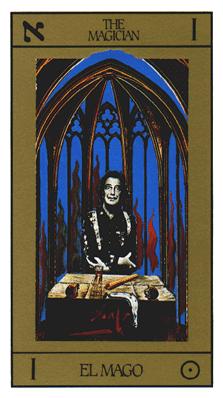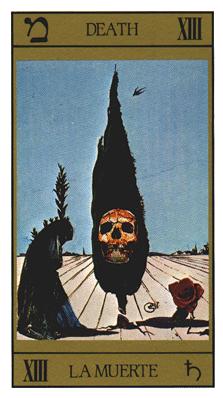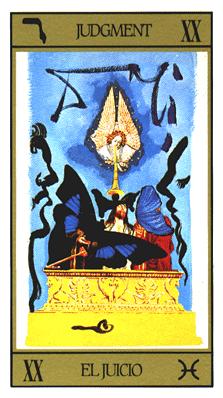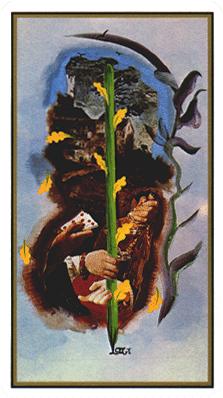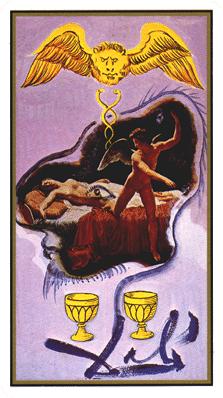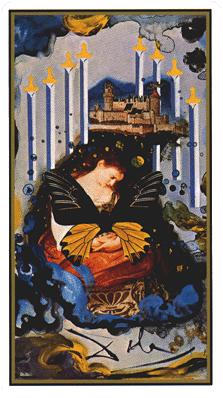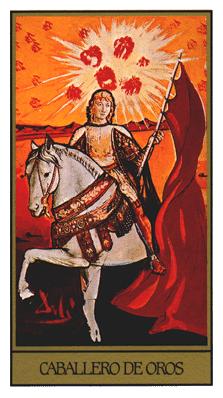Dali Universal Tarot Deck Review
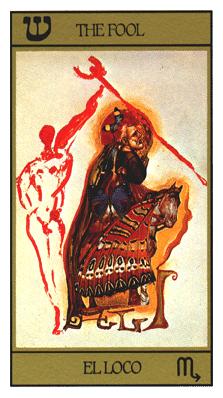
The Dali Universal Tarot was purportedly created by Salvador Dali himself, as a commission in the 1970s. The 78 card has been published in two editions: the rare gold enhanced version and now this less pricey and more obtainable edition from Taschen.
Deck Type: Tarot Deck Cards: 78
Creators: Juan Llarch, Salvador Dali
Publisher: US Games
Publisher: Taschen 2014
Retailers
See Price at Amazon.comSee Price at Amazon.ca
Dali Universal Tarot Review by Gina
Knowing my fascination for all things Dali and my love for Tarot, my other half presented me with the perfect gift last year. I dove right in, spent hours looking at each card, and finally pronounced it my Blood and Butterflies deck. Perhaps it was the fever that turned into a flu within 24 hours which made me see so much of the color red in the cards. I loved the deck, but felt that it was more of a collectable deck than anything that I would ever use in an actual reading.
Last week I unshelved the Tarot Universal Dali, to share with a friend, and found myself taking a second and much deeper look. The deck is packaged in a box within a box. The outer box is covered in burgundy-red velvet with gold lettering, and the inner case containing the cards is a sturdy, dark brown, cardboard affair, also with gold lettering. Dali as The Magician (El Mago) graces the cover of the inner box, and he immediately confronts the Reader with his amazed countenance over a work table that holds a broken loaf of bread, a glass of half-consumed wine, a roll of parchment, and a clock face melting off the table away from the artist.
And so, I searched the deck for ants, grasshoppers, female genitalia, and more fabulously melting clocks. I did not find many more trademarks of Salvador Dalis early surrealist years. Instead, I stepped into a collaged world of clipped, classical Western art and Dali doodles which mimic and mock the very art upon which they are superimposed. I realize that is a lot of alliteration for one sentence, but after looking at this deck more closely, I have added brooding and bruised to Blood and Butterflies.
The edges are gilt and the borders are white and narrow. The cards are larger than standard at about 3 by 5 inches, and the deck feels and looks rich. The card stock is not heavy, but sturdy.
The book that comes with the deck was written in Spanish, with English, French and German translations, and provides brief descriptions of the Major Arcana, hinting at alchemical symbolism. It also contains diagrams for three layouts, but fails to describe any method for interpreting the cards within any of the spreads shown.
The Major Arcana bear English titles on top and Spanish titles below, each upon a broad, gold band, and are numbered I through XXI from the Magician to the World. Justice is numbered VIII and Strength is XI. Hebrew letters are assigned to the cards starting with Aleph at the Magician through Resh at Judgment, and Tau is assigned to The World. The Fool is unnumbered and the Hebrew letter Shin graces the top band. Planetary and Zodiacal associations are somewhat different from those found on many modern decks. For instance, The Empress is Earth, Temperance is Aquarius, and The World is Taurus.
With few exceptions, the Majors are active, masculine and forceful. Even cards that traditionally feel contemplative, are interpreted with a sense of urgency in Dalis world. The High Priestess is almost standing, her eyes are open, and she leans forward toward the Reader as if SHE is asking the question! The Lovers, classically nude or would be if the artist had not placed that great, blue butterfly over the male lovers mid-section, while leaving the female lover quite unclothed watch a bright red, doodled snake drip down between them from the red, doodled tree above. And all the imagery of The Lovers is placed upon a red background that simply screams, Do something even if its wrong!
The Minor Arcana Ace through Ten in each suit have no writing upon them, but are easily identifiable from the pictures which are similar, if only Dali-skewed, to those of a Rider-Waite-Smith deck. And each Ace through Ten contains the requisite number of staffs, cups, swords or discs upon its face. Court Cards are titled in Spanish. The Suits Bastos, Copas, Espadas and Oros refer to Rods or Staffs, Cups, Swords and Discs, respectively. And the Court Cards Sota, Caballero, Reina and Rey are Page, Knight, Queen and King, in that order.
Most of the Staffs scenes are set upon a light gray backwash, and are graced with bright green staffs with even brighter yellow leaves. In a display of hands one holding playing cards, one with a bottle, and two womens hands (both left hands, and obviously not the same woman) Dali places the passions of gambling front and center on the Ace of Staffs. With a slight reprieve at the Four of Staffs for celebration and a bit of dancing, this suit grows heavier. Perhaps Dali thought that he was too heavy handed and decided to hide all but a bit of the action of the Five and Ten with massive butterflies. My favorite card of this suit is El Rey de Bastos. It is a child king that is seated on the throne, and he holds a massive staff upright between his legs in a purely phallic gesture.
The scenes of the Cups are set primarily upon shades of blue. The Ace of Cups is beautiful in its simplicity. A blue sky, a lone sail boat on a beach, a lone fisherman with a net, a great golden chalice with cloudy, white wings is centered above the horizon. In comparison, the rest of the cups cards contain simple line drawings of goblets colored yellow. It is as if at the Ace of Cups, Dalis own ability to be open to relationships is a far more real and greater treasure than the actual pursuit of emotional attachment or attainment of love.
The Swords are played out against a pale blue or light gray background, though the Three of Swords is red, Red, RED, and perhaps, one of the most painful of its kind that I have ever seen. Angels battle sea demons as our fair maiden (Andromeda?) is chained to a rock awaiting rescue all within a great black heart pierced by silver gray broadswords with yellow hilts, and surrounded by RED!
The Discs are shades of blue and gold, and all but the Caballero de Oros contain pentacles drawn in red or black against a yellow disc outlined in red. The Page of Discs stands out from the entire deck in a singular, sincere moment of peace as a young girl reaches for a shiny button. Even here, Dali scribbles a dark dragon rising behind her, though it faces away from her as if it isnt prepared to steal her innocence just yet. As the cards come packaged, Dalis is the first face you see on the brown box in the image of The Magician, and he takes the throne on the last card of the deck as El Rey de Oros. Our King of Discs is dressed well in black suit, white shirt and shiny black shoes, and it appears that he is holding the leash of a cheetah. He has scribbled over the image and left his fingerprints in red ink, of course.
Dali turned 80 in 1984, the year this deck was first published in Spain. Rumor has it that he created this deck at the behest of his wife, Gala, who was fascinated with the Tarot. More plausible an explanation is that the artist accepted a commission to create a Tarot deck at the behest of his wife who handled their financial affairs to make money to support the couples extravagant lifestyle in their waning years.
If it isnt enough that Dali signed every single card in the deck with a flourish, the card backs are a symmetrical design of Dalis famous signature (approximately 95 of them). Lets see: 78 + 95 = 173. Wait while I do the math. At the going retail price of $100.00 (US) per deck, thats 57.8 cents per signature and enough reason for a true Dali fan to purchase the deck.
Have I read with Tarot Universal Dali? No. I just cant get over the unbalanced feel of the deck. Do I love these cards? I have peeked into the mind of the aging Dali skewed, human, and found blood and butterflies, brooding and bruises and I do love this deck. Yes, its a collectible, and one that I will share often. And perhaps, one day, when I'm brooding, I'll even read with it.
Dali Universal Tarot Review by George Washington, Jr.
This is a review of the reprint of the original Tarot Universal Dalí, which differs in that the card edges are not gilded, and the price is correspondingly lower. It's otherwise identical to the original.
This is a stunning deck, a full realization of the talents of one of the 20th century's greatest artists. While many decks have been created by fine artists and illustrators, this is the only one done by a world-class artist, unless you count the archtypal images of Giotto di Bondone that prefigured some of the early versions of the Major Arcana, or if you insist that Bonifacio Bembo, who is the most likely person to have painted the 15th century Visconti-Sforza Tarot, was the Renaissance-era equivalent of Dalí. And while there are decks like the Leonardo da Vinci Tarot, The Tarot of Dürer, and the Bosch Tarot, these are modern adaptations of the work of artists who never intended to create their own Tarot decks.
Nevertheless, the fact remains that the Dalí Tarot is the only modern, and by that I mean post Smith-Waite deck created by an artist of this stature. Perhaps if Van Gogh or Gauguin or even Jackson Pollock had been inspired to create their own Tarot deck, Dalí might have some competition, but as it is, his stands alone in this regard. I can only speculate why this is. Perhaps the requisite limitations of the Tarot deck in terms of subject matter and size have made it unappealing to other artists on Dalí's level. If this is the case, we should be glad that Dalí put any objections aside to tackle this project.
The Dalí Tarot is a collage deck, with cards taking as their central theme images adapted from classical art, along with various other minor elements and the requisite suit signs added as simple drawings in solid colors. A number of cards are Dalí's own original work; several of these are outstanding in their own right. For example, the Death card is a cypress tree with a skull, floating above its cut trunk. In most cases the images correspond to the standard Smith-Waite iconography, and anyone familiar with Smith's deck should have no trouble with the Dalí. The cards include the planetary and Kabalistic correspondences, with titles in Spanish and English. The backs are gold with a repeating pattern of Dali's signature.
The accompanying book is one of the best I've seen, printed with the card images in full color, and including descriptions of the artwork where known (the identity of the images on several cards is unidentified, shown as "further information requested" footnoted with the admission that research has been unsuccessful, and for anyone with information to contact the book's author, Johannes Fiebig). It's packed in a hard box, although I would have preferred a plastic tray for the cards rather than the cardboard one which tends to make extraction of the bottom card challenging as it catches on the slight irregularities in the edges. The cards themselves are of the highest quality, on fine stock with clear and detailed images. The cards are printed by "Evergreen" in Germany, while the accompanying book is printed in China.
While Pamela Colman-Smith was a fine illustrator, as evidenced by her other work included with the Smith-Waite Centennial Tarot Deck commemorative edition, she was a poor draftsman, and for me, the clumsiness in the rendition of several cards in her deck is off-putting. What her deck does have is an inexplicable atmosphere of mystery - it was the first Tarot deck I ever saw, and despite the cartoonish quality, it seemed to have an indescribable connection to a detailed reality both within and beyond it, although I've never felt motivated to use it for anything other than keeping a copy as a collector's item and vital link in the history of Tarot. While many subsequent decks have been far better designed and executed, I've never encountered that same quality in any other one - until I came across the Dalí.
This is more than another Smith-Waite clone; it's
both a unique expression of Dalí's vision,
simultaneously a reverent hommage and a satirical parody,
operating on multiple levels that would take a great deal of
study to become conversant in, while at the same time,
accessible on a superficial basis, or whatever level the
reader wishes to approach it. At the current price of
around $25, should not be missed by anyone interested
either in Dalí or the Tarot.
Complete Details of Dali Universal Tarot
Creators: Juan Llarch, Salvador DaliPublisher: US Games
Publisher: Taschen 2014
Deck Type: Tarot Deck
Cards: 78
The Fool is 0
Rating: 14/20 or
Similar Decks to Dali Universal Tarot
Theme: Art Styled, SurrealCategory: Available Tarot Decks
< Previous Deck · Back to Top · Next Deck >
Home > Tarot Reviews > Dali Universal Tarot Review

